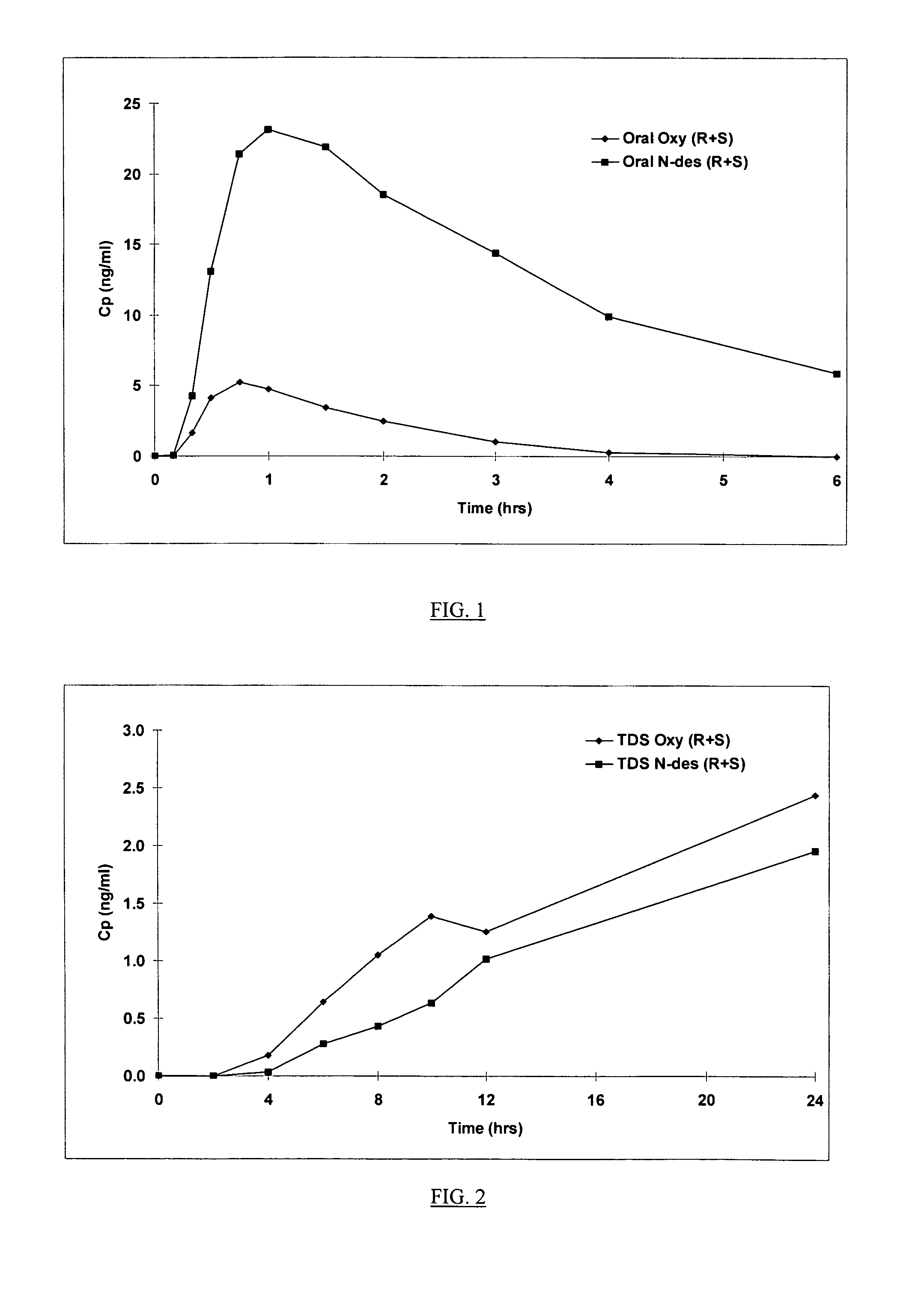Compositions and methods for transdermal oxybutynin therapy
a technology of oxybutynin and composition, applied in the field of pharmaceutical sciences and medicine, to achieve the effect of reducing the experience of anticholinergic or antimuscarinic drug effects
- Summary
- Abstract
- Description
- Claims
- Application Information
AI Technical Summary
Benefits of technology
Problems solved by technology
Method used
Image
Examples
example 1
Preparation of Oxybutynin Adhesive Matrix Patch
[0153]The non-oral oxybutynin delivery devices used in the clinical study referred to above were 13 and / or 39 cm2 transdermal adhesive matrix patches. A general method of preparing transdermal adhesive matrix patches is described by U.S. Pat. Nos. 5,227,169, and 5,212,199, which are incorporated by reference in their entirety. Following this general method, the oxybutynin patches of this invention were prepared as follows:
[0154]Oxybutynin free base, triacetin (Eastman Chemical Co., Kingsport, N.Y.) and 87–2888 acrylic copolymer adhesives (National Starch and Chemical Co., Bridgewater, N.J.) were mixed into a homogenous solution and coated at 6 mg / cm2 (dried weight) onto a silicone treated polyester release liner (Rexham Release, Chicago, Ill.) using a two zone coating / drying / laminating oven (Kraemer Koating, Lakewood, N.J.) to provide a final oxybutynin adhesive matrix containing 15.4%, 9.0%, and 75.6% by weight oxybutynin, triacetin an...
example 2
Preparation of Oxybutynin Biodegradable Microsphere Depot Injection
[0155]Biodegradable microspheres for effecting a sustained-release depot injection may be used to deliver oxybutynin in accordance with the method of the present invention. Microspheres were prepared by the following method:
[0156]12,000 molecular weight poly-d,l lactic acid (“PLA”, Birmingham Polymers, Birmingham, Ala.) was dissolved into methylene chloride at a final concentration of 20% by weight. Oxybutynin free base was dissolved into the PLA solution at 4% by weight in the final solution. A water-jacketed reaction vessel (temperature controlled at 5 degrees Celsius) equipped with a true-bore stirrer fitted with a Teflon turbine impeller was charged with a de-ionized water containing 0.1% Tween 80.
[0157]The oxybutynin / PLA / methylene chloride solution was added drop wise into the reaction vessel and stirred to dispense the organic polymer phase within the aqueous solution as fine particles. The resultant suspension...
example 3
Preparation of Topical Oxybutynin Formulation
[0158]Topically applied oxybutynin containing gel may be used to deliver oxybutynin in accordance with the method of the present invention. A general method of preparing a topical gel is known in the art. Following this general method, a topical gel comprising oxybutynin was prepared as follows:
[0159]95% ethanol (USP) was diluted with water (USP), glycerin (USP), and glycerol monooleate (Eastman Chemical, Kingsport N.Y.) to provide a final solution at ethanol / water / glycerin / glycerol monooleate percent ratios of 35 / 59 / 5 / 1, respectively. Oxybutynin free base was then dissolved into the above solution to a concentration of 10 mg / gram. The resultant solution was then gelled with 1% hydroxypropyl cellulose (Aqualon, Wilmington, Del.) to provide a final oxybutynin gel. One to two grams of the above gel is applied topically to approximately 200 cm2 surface area on the chest, torso, and or arms to provide topical administration of oxybutynin.
PUM
| Property | Measurement | Unit |
|---|---|---|
| concentration | aaaaa | aaaaa |
| concentration | aaaaa | aaaaa |
| concentration | aaaaa | aaaaa |
Abstract
Description
Claims
Application Information
 Login to View More
Login to View More - R&D
- Intellectual Property
- Life Sciences
- Materials
- Tech Scout
- Unparalleled Data Quality
- Higher Quality Content
- 60% Fewer Hallucinations
Browse by: Latest US Patents, China's latest patents, Technical Efficacy Thesaurus, Application Domain, Technology Topic, Popular Technical Reports.
© 2025 PatSnap. All rights reserved.Legal|Privacy policy|Modern Slavery Act Transparency Statement|Sitemap|About US| Contact US: help@patsnap.com



